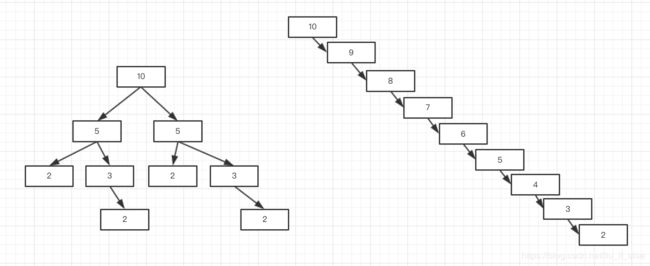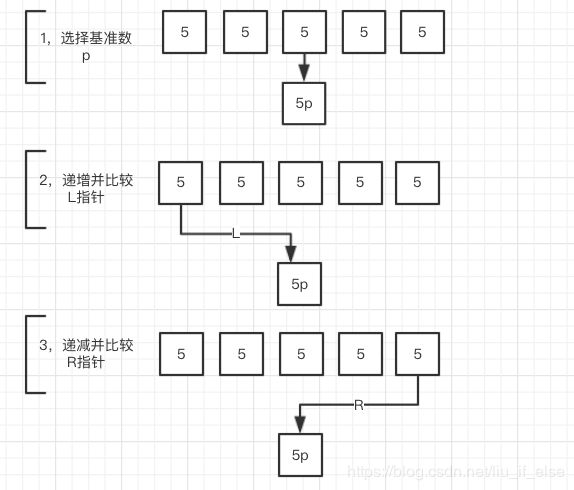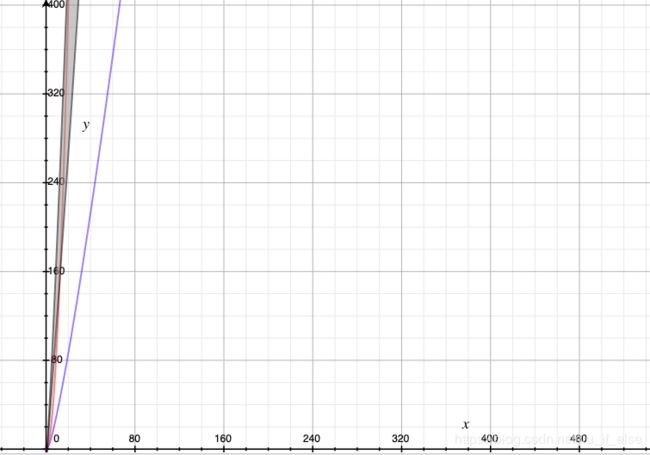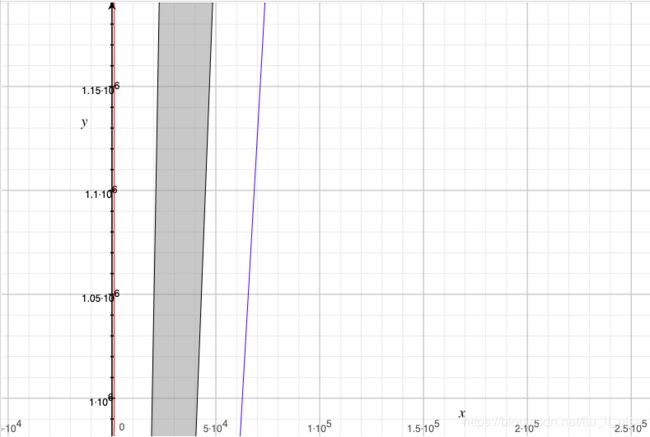时间复杂度-线性对数时间nlogn的一些研究
文章目录
- 排序算法的时间复杂度
- 二叉树与 n l o g 2 n nlog_2^n nlog2n
- 快速排序的大致复杂度分析
- 进一步的复杂度分析
- 最坏情况worst case
- 最佳情况best case
- 用表达式计算更加精确的复杂度
- 分析
- 测试
- 图像
排序算法的时间复杂度
时间复杂度的本质就是一个函数f(x)=y,其中y是时间,x是被操作的元素数量,分析的是随着x元素的增加,计算机所需计算时间y的变化。时间复杂度的写法是 O ( x ) O(x) O(x),x是元素数量,O返回的是时间,时间复杂度不会追求计算机完成该算法的精确时间,也没办法计算,例如计算机对于不同的数据类型例如float或int所需的计算时间肯定是不同的,所以O()只是对一种xy线性关系粗糙的描述。
绝大部分的排序算法的平均时间复杂度就是两种,慢的 O ( n 2 ) O(n^2) O(n2)或是快的 O ( n ∗ l o g 2 n ) O(n*log_2^n) O(n∗log2n)。 O ( n 2 ) O(n^2) O(n2)数学的名字叫quadratic time平方时间 ,从代码的角度看就是两个for循环,比如说 n = 5 2 = 25 n=5^2=25 n=52=25,那么两个五次for循环正好是25次循环,下面要研究的是 O ( n ∗ l o g 2 n ) O(n*log_2^n) O(n∗log2n),linearithmic time线性对数时间。
二叉树与 n l o g 2 n nlog_2^n nlog2n
假设n为一个2的倍数,它可以以二叉树的形式不断向下二分,设这个树的深度为k,可以看出每一层的节点内的数的和都是n,那么整个树所有节点的合为n*k

[图1]
从上图中可以看出每个节点内的数量还可以用 1 2 a ∗ n \frac{1}{2^a}*n 2a1∗n来表示,观察最底层可得出:
1 = 1 2 k − 1 ∗ n 1=\frac{1}{2^{k-1}}*n 1=2k−11∗n
既是
2 k − 1 = n 2^{k-1}=n 2k−1=n
根据对数公式:
k − 1 = l o g 2 n k-1=log_{2}^{n} k−1=log2n
k = l o g 2 n + 1 k=log_{2}^{n}+1 k=log2n+1
已知 s u m = n ∗ k sum=n*k sum=n∗k所以:
s u m = n ∗ ( l o g 2 n + 1 ) = n l o g 2 n + n sum=n*(log_{2}^{n}+1)=nlog_{2}^{n}+n sum=n∗(log2n+1)=nlog2n+n
分治算法的基本思想是将一个规模为N的问题分解为K个规模较小的子问题,当用二分法进行问题分解时,这里 n l o g 2 n nlog_{2}^{n} nlog2n可以代表在最完美的二分情况下的各个子问题的和。代入进 O ( n l o g 2 n + n ) O(nlog_{2}^{n}+n) O(nlog2n+n),最后的n按O()约定可以当常数约掉(另外很多算法里当问题的规模只有1时计算就已经结束了, O ( n l o g 2 n ) O(nlog_{2}^{n}) O(nlog2n)反而更加精准)。下面分析一个具体的nlogn算法。
快速排序的大致复杂度分析
本文分析的案例是快速排序,快排根据如何对数组进行划分再次递归有一些不同的版本,在一些case上的复杂度会有些区别,以下是称为Hoare分区法的C#版本
C#代码:
void Quicksort(int[] arr, int low, int high)
{
if (low < high)
{
int pivot = arr[(low + high) / 2];
int left = low - 1;
int right = high + 1;
while (true)
{
do
{
left++;
} while (arr[left] < pivot);
do
{
right--;
} while (arr[right] > pivot);
if (left >= right)
{
pivot = right;
break;
}
//交换
int leftCopy = arr[left];
arr[left] = arr[right];
arr[right] = leftCopy;
}
Quicksort(arr, low, pivot);
Quicksort(arr, pivot + 1, high);
}
}
参数arr是被处理的数组,low是0,high是arr.length-1,从代码可以看出只要输入元素大于两个,那么Quicksort就会进行递归,Sort函数返回的pi可以看做是一个锚点,它将arr划分为两个部分,交给Quicksort分别处理,如果将Sort的递归调用画为一个二叉树,pi就决定了二叉树的分叉情况

(图1:将Sort递归调用次数画为二叉树)
上图假设arr的长度为10,每个节点代表一次Quicksort调用,节点内数字代表当前函数调用需要处理的数组元素数量,当元素等于1时不会调用。上文已经分析越是完美二分的二叉树,它的深度越接近logn+1,由于这里把1的叶子节点删除了,所以这里的深度k变为了logn。左面的二叉树高度非常接近 l o g 2 10 = 3.32 log_2^{10}=3.32 log210=3.32。从上图可以看出越是一个平衡的二叉树它需要处理的元素越少,右边那种极端非平衡的树需要处理的元素总数是最多的。但是该算法的复杂度不只和Quicksort函数的调用次数有关,更主要的是函数内部的操作数量,实际的复杂度还要具体分析。但是上图还是可以反映出一个一般趋势,既是良好平衡的划分有助于降低复杂度。
进一步的复杂度分析
最坏情况worst case
Quicksort函数最主要的操作是数组遍历与数组交换,left与right从arr数组两边向中央移动遍历直到相交,在移动过程中如果发现有需要交换的数就进行交换,当left与right相交后则返回right作为pi锚点将数组一分为二进行递归。
每次数组元素交换行为都会导致right向左移动一位,如果说图1右方的二叉树是最坏情况,那么对于1个长度为10的arr,它的具体行为就是:
left左移10次
right右移1次
交换1次
交换有三行代码,总操作次数为10+1+3=14。
但是考虑一个10个相同数的数组:
left左移5
right右移6次
交换5次
5+6+5*3=26次操作。由于等值数组的二分是完全平衡的,n的大小与交换次数成等比例关系,在n>100时,全等数组就是该算法的worst case。(实测当n不是很大的时候,有些特殊形式的数组操作数量会超过全等值数组例如aaaabaaaab,a
(图2:Quciksort处理等值数组时的具体行为)

(图3:Quciksort处理等值数组时的具体行为)

(图4:Quciksort处理等值数组时的具体行为)
最佳情况best case
从上文已知交换次数会导致复杂度上升,平衡二分会导致复杂度下降。那么一个不需要交换的平衡二叉树既是best case。它就是一个已经排好序的数组,例如1,2,3,4,5,6,7,8,9,10。不需要任何交换并且每次都是在中央二分。
用表达式计算更加精确的复杂度
分析
首先要更加仔细的剖析代码,给各个操作划分case计数。
Unity测试脚本:
using System.Collections;
using System.Collections.Generic;
using UnityEngine;
public class QuickSortBlog : MonoBehaviour {
//计数器
struct counter
{
public int operations; //操作计数
public int qsCalls; //Quicksort方法调用次数
public int qsValidCalls; //有效的Quicksort方法调用次数(操作数大于2)
public int swapCount; //交换次数
public int moveCount; //移动次数
};
counter c;
counter randomMaxC;
int[] randomMaxArr;
// Use this for initialization
void Start () {
c=new counter();
c.operations = 0;
c.qsCalls = 0;
c.qsValidCalls = 0;
c.swapCount = 0;
c.moveCount = 0;
int[] arr = new int[10] { 1, 2, 3, 4, 5, 6, 7, 8, 9, 10};
Quicksort(arr, 0, 9);
Debug.Log("successive numbers,operations:" + c.operations + ",qsCalls:" + c.qsCalls + ",qsValidCalls:" + c.qsValidCalls + ",swapCount:" + c.swapCount+",moveCount:"+c.moveCount);
c.operations = 0;
c.qsCalls = 0;
c.qsValidCalls = 0;
c.swapCount = 0;
c.moveCount = 0;
arr = new int[10] { 8, 8, 8, 8, 8, 8, 8, 8, 8, 8};
Quicksort(arr, 0, 9);
Debug.Log("same numbers,operations:" + c.operations + ",qsCalls:" + c.qsCalls + ",qsValidCalls:" + c.qsValidCalls + ",swapCount:" + c.swapCount + ",moveCount:" + c.moveCount);
/*Quicksort处理aaaabaaaab形式数组有更差的性能表现
c.total = 0;
c.qsCall = 0;
c.validQSCall = 0;
c.swapCall = 0;
c.move = 0;
temp = new int[10] { 6,6,6,6,8,6,6,6,6,8 };
Quicksort(temp, 0, 9);
Debug.Log("aaaabaaaab,numbers:" + c.operations + ",qsCalls:" + c.qsCalls + ",qsValidCalls:" + c.qsValidCalls + ",swapCount:" + c.swapCount + ",moveCount:" + c.moveCount);
*/
//10000次随机测试
randomMaxC = new counter();
randomMaxC.operations = 0;
randomMaxC.qsCalls = 0;
randomMaxC.qsValidCalls = 0;
randomMaxC.swapCount = 0;
randomMaxC.moveCount = 0;
for (int i = 0; i < 100000;i++){
RandomDebug();
}
Debug.Log("random numbers,operations:" + randomMaxC.operations + ",qsCalls:" + randomMaxC.qsCalls + ",qsValidCalls:" + randomMaxC.qsValidCalls + ",swapCount:" + randomMaxC.swapCount+ ",moveCount:" + randomMaxC.moveCount);
for (int i = 0; i < 10; i++)
{
Debug.Log(randomMaxArr[i].ToString());
}
}
//随机数组生成与测试
void RandomDebug(){
c.operations = 0;
c.qsCalls = 0;
c.qsValidCalls = 0;
c.swapCount = 0;
c.moveCount = 0;
int[] debugArray = new int[10];
int[] copyArray = new int[10];
for (int i = 0; i < 10;i++){
debugArray[i] = Random.Range(1, 11);
copyArray[i] = debugArray[i];
}
Quicksort(debugArray, 0, 9);
SelectRandomMax(copyArray);
}
//worst case筛选
void SelectRandomMax(int[] arr){
if(c.operations>randomMaxC.operations){
randomMaxArr = arr;
randomMaxC.operations = c.operations;
randomMaxC.qsCalls = c.qsCalls;
randomMaxC.qsValidCalls = c.qsValidCalls;
randomMaxC.swapCount = c.swapCount;
randomMaxC.moveCount = c.moveCount;
}
}
void Quicksort(int[] arr, int low, int high)
{
c.qsCalls++;
c.operations++;
if (low < high)
{
c.qsValidCalls++;
int pivot = arr[(low + high) / 2];
int left = low - 1;
int right = high + 1;
c.operations+=3;
while (true)
{
do
{
left++;
c.operations++;
c.moveCount++;
} while (arr[left] < pivot);
do
{
right--;
c.operations++;
c.moveCount++;
} while (arr[right] > pivot);
if (left >= right)
{
pivot = right;
c.operations += 2;
break;
}
c.swapCount++;
c.operations++;
//交换
int leftCopy = arr[left];
arr[left] = arr[right];
arr[right] = leftCopy;
c.operations+=3;
}
Quicksort(arr, low, pivot);
Quicksort(arr, pivot + 1, high);
c.operations+=2;
}
}
}
结合上面代码与图1可以归纳出以下几点,当arr长度为n时:
worst case最差情况:
1,有效调用(arr长度大于2)Quicksort方法n-1次。每次调用与之相关的操作有8次。
2,无效调用Quicksort方法n次。每次调用与之相关的操作有1次。
3,问题分治的二叉树高度基本等于logn。
4,在二叉树每一层,数组元素交换相关操作次数根据奇偶数case平均后等于n+1.5。
5,在二叉树每一层,数组遍历相关操作次数根据奇偶数case平均后等于(n/2+0.25)*4。
best case最佳情况:
1,2,3,5同上。第4条数组元素交换次数为0。
结合以上情况可得出表达式:
worst case:
f ( n ) = ( n − 1 ) ∗ 8 + n + l o g 2 n ∗ ( ( n 2 + 0.25 ) ∗ 4 + ( n + 1.5 ) ) f(n)=(n-1)*8+n+log_2^n*((\frac{n}{2}+0.25)*4+(n+1.5)) f(n)=(n−1)∗8+n+log2n∗((2n+0.25)∗4+(n+1.5))
best case:
f ( n ) = ( n − 1 ) ∗ 8 + n + l o g 2 n ∗ ( n + 1.5 ) f(n)=(n-1)*8+n+log_2^n*(n+1.5) f(n)=(n−1)∗8+n+log2n∗(n+1.5)
测试
1,n=10
最佳情况,连续数字
Unity脚本:operations=125
表达式计算结果:f(n)=120.2
最差情况,相同数字
Unity脚本:operations=190
表达式计算结果:f(n)=189.96
2,n=100
最佳情况,连续数字
Unity脚本:operations=1663
表达式计算结果:f(n)=1566.35
最差情况,相同数字
Unity脚本:operations=2986
表达式计算结果:f(n)=2901.7
3,n=1000
最佳情况,连续数字
Unity脚本:operations=19967
表达式计算结果:f(n)=18972.3
最差情况,相同数字
Unity脚本:operations=40582
表达式计算结果:f(n)=38914.27
表达式计算出的值与真实数字还是有一些误差,主要是二叉树深度那块的处理方案还是有问题。
图像
有了表达式就可以画图了。红线是 O ( n 2 ) O(n^2) O(n2),蓝线是 O ( n l o g n ) O(nlogn) O(nlogn),灰色区域是best case和worst case表达式的积分面积,该算法所有case的复杂度都在这范围内

(图5:n<100)

(图5:n<1000)

(图5:n<50000)
参考:
Quicksort–hoare partition scheme:https://en.wikipedia.org/wiki/Quicksort#Hoare_partition_scheme
时间复杂度 O(log n) 意味着什么?:https://juejin.im/entry/593f56528d6d810058a355f4
A Gentle Introduction to Algorithm Complexity Analysis: https://discrete.gr/complexity/
维护日志:
2020-2-5:修改整理